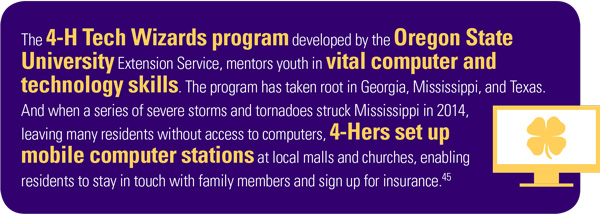Section 3: Public Research Universities Serve Their Communities
Public research universities are centers of cultural learning; they house museums, theaters, and athletic centers that are open to the public. These hubs enhance the quality of community life by serving as access points to arts, performance, and athletic events; offering recreational activities and educational outreach to K–12 schools; and engaging undergraduate and graduate students in internships and direct service. Public research universities also drive efforts to improve student achievement. Through the Albany Promise, a regional, cross-sector partnership, the University at Albany, SUNY has created a district-wide assessment for incoming kindergarteners, aligned in-school and after-school programs, and increased SAT participation among high school seniors by 29 percent (from 53 percent in AY2013 to 82 percent in AY2014).43
Housed at Rutgers University-Newark, the Newark City of Learning Collaborative (NCLC) works with area public higher education institutions, over 60 local organizations, major corporations, Newark Public Schools, and the City of Newark to raise the percentage of residents in Newark with a postsecondary degree from 17 to 25 percent by 2025. The NCLC collectively tracks citywide enrollment, retention, and completion while also strengthening college readiness programs; simplifies and aligns college pathways from high school to postsecondary institutions; and increases financial support and career development opportunities for young students and adult-learners alike.44

Professional schools at public research universities also foster community service and engagement. The Center for Rural Health and Social Service Development at Southern Illinois University’s School of Medicine educates members of the community on important health topics. One of their programs works to fill education gaps in southern Illinois by hosting workshops, trainings, and conferences for rural health care and social service providers.46 Similarly, the Public Interest Institute through the University of Alabama’s School of Law actively seeks out opportunities for pro bono service and participates in Birmingham’s annual Project Homeless Connect.47
As concerns about resource scarcity continue to intensify, public research universities have made important advances in managing land and natural resources. The University of Arizona, Pima County and the city of Tucson recently opened the Water & Energy Sustainable Technology (WEST) Center, a public-private-academic partnership that helps communities manage water scarcity and develop new technologies necessary to improve water security.48 In this way, the University of Arizona is able to bring its extensive research and intellectual capital to the businesses and public works programs that can transform them into action.Many public research universities offer large extension programs—both traditional and urban—that offer degree-granting and nondegree educational opportunities through outreach and distance learning. Oklahoma State University is offering a Massive Open Online Course (MOOC) entitled “Farm to Fork: A Panoramic View of Agriculture,” which connects students with the agricultural practices and workers who provide the food they consume. Last spring, more than seventy Oklahoma State students enrolled in the online course for credit and more than seven hundred learners from within and outside the student community participated for free.49
Public research universities also play a special role with 4-H, the youth development program of the Cooperative Extension System of land-grant universities. Universities provide research-driven programming to help 4-Hers engage in hands-on learning activities in the areas of science, citizenship, and healthy living, and help 4-Hers respond directly to areas of need in their communities. With a network of six million youths, six hundred thousand volunteers, thirty-five hundred professionals, and more than twenty-five million alumni, the impact and reach of the organization is vast.50
ENDNOTES
43 University at Albany News Center, “The Albany Promise Cradle to Career Partnership Releases 2014 Report Card,” February 25, 2015, http://www.albany.edu/news/57977.php; and the Albany Promise, 2014 Report Card (Albany, N.Y.: The Albany Promise, 2015), http://www.albany.edu/news/files/ReportCard_2014-2.pdf.
44 Newark City of Learning Collaborative, http://www.nclc2025.org.
45 National 4-H Council, 2014 Youth Impact Report (Chevy Chase, Md.: National 4-H Council, 2014), 6, http://4-h.org/about/annual-report.
46 Southern Illinois University, “CRHSSD,” http://crhssd.siu.edu/.
47 The University of Alabama School of Law, “Pro Bono & Public Service Opportunities,” http://www.law.ua.edu/public-interest-institute/volunteer-opportunities/.
48 UANews, “New WEST Center to Address Water Issues,” University of Arizona, November 24, 2015, http://uanews.arizona.edu/story/new-west-center-to-address-water-issues.
49 Jacy Bradford, “Take an Online ‘Farm to Fork’ Journey,” NewsOK, December 18, 2015, http://newsok.com/take-an-online-farm-to-fork-journey/article/5467604.
50 4-H, “4-H Youth Development & Mentoring Programs,” http://www.4-H.org/about/.